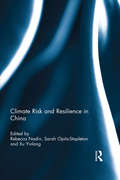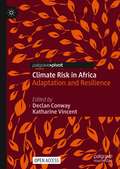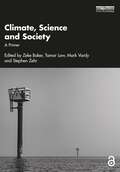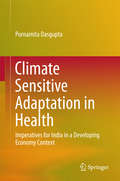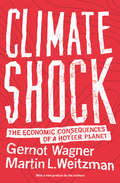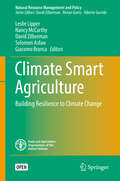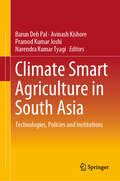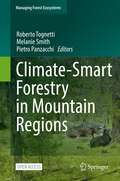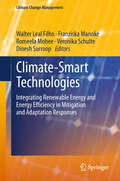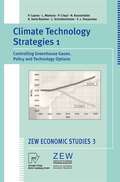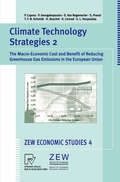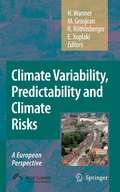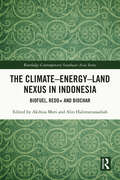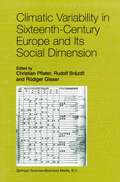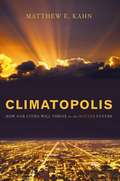- Table View
- List View
Climate Risk and Resilience in China
by Rebecca Nadin Sarah Opitz-Stapleton Xu YinlongChina has been subject to floods, droughts and heat waves for millennia; these hazards are not new. What is new is how rapidly climate risks are changing for different groups of people and sectors. This is due to the unprecedented rates of socio-economic development, migration, land-use change, pollution and urbanisation, all occurring alongside increasingly more intense and frequent weather hazards and shifting seasons. China’s leadership is facing a significant challenge – from conducting and integrating biophysical and social vulnerability and risk assessments and connecting the information from these to policy priorities and time frames, to developing and implementing policies and actions at a variety of scales. It is within this challenging context that China’s policy makers, businesses and citizens must manage climate risk and build resilience. This book provides a detailed study of how China has been working to understand and respond to climatic risk, such as droughts and desertification in the grasslands of Inner Mongolia to deadly typhoons in the mega-cities of the Pearl River Delta. Using research and data from a wide range of Chinese sources and the Adapting to Climate Change in China (ACCC) project, a research-to-policy project, this book provides a fascinating glimpse into how China is developing policies and approaches to manage the risks and opportunities presented by climate change. This book will be of interest to those studying global and Chinese climate change policy, regional food, water and climate risk, and to policy advisors.
Climate Risk in Africa: Adaptation and Resilience
by Declan Conway Katharine VincentThis open access book highlights the complexities around making adaptation decisions and building resilience in the face of climate risk. It is based on experiences in sub-Saharan Africa through the Future Climate For Africa (FCFA) applied research programme. It begins by dealing with underlying principles and structures designed to facilitate effective engagement about climate risk, including the robustness of information and the construction of knowledge through co-production. Chapters then move on to explore examples of using climate information to inform adaptation and resilience through early warning, river basin development, urban planning and rural livelihoods based in a variety of contexts. These insights inform new ways to promote action in policy and praxis through the blending of knowledge from multiple disciplines, including climate science that provides understanding of future climate risk and the social science of response through adaptation.The book will be of interest to advanced undergraduate students and postgraduate students, researchers, policy makers and practitioners in geography, environment, international development and related disciplines.
Climate Risks: An Investor's Field Guide to Identification and Assessment (The Wiley Finance Series)
by Bob BuhrAssess the likelihood, timing and scope of climate risks In Climate Risks: An Investor’s Field Guide to Identification and Assessment, financial analyst Bob Buhr delivers a risk-based framework for classifying and measuring potential climate risks at the firm level, and their potential financial impacts. The author presents a “climate risk taxonomy” that encompasses a broad range of physical, transition and natural capital risks that may impact a firm’s financial profile. The taxonomy presented in the book will be of interest to investors and lenders involved in: The identification and assessment of the potential scope and impact of a wide range of risks that might normally remain outside of more traditional risk or credit analysis, usually for horizon issues; The determination of the points at which climate risks may crystallize into real and significant financial exposure The assessment of the relative aggregate riskiness of portfolios exposed to climate and natural capital risks at the firm levelA rigorous and practical toolkit for the assessment and measurement of a broad range of potential climate risks, this book offers fund managers, portfolio analysts, risk experts, and other finance professionals a clear blueprint for assessing potential financial impacts at firms arising from climate change.
Climate Risks: An Investor's Field Guide to Identification and Assessment (The Wiley Finance Series)
by Bob BuhrAssess the likelihood, timing and scope of climate risks In Climate Risks: An Investor’s Field Guide to Identification and Assessment, financial analyst Bob Buhr delivers a risk-based framework for classifying and measuring potential climate risks at the firm level, and their potential financial impacts. The author presents a “climate risk taxonomy” that encompasses a broad range of physical, transition and natural capital risks that may impact a firm’s financial profile. The taxonomy presented in the book will be of interest to investors and lenders involved in: The identification and assessment of the potential scope and impact of a wide range of risks that might normally remain outside of more traditional risk or credit analysis, usually for horizon issues; The determination of the points at which climate risks may crystallize into real and significant financial exposure The assessment of the relative aggregate riskiness of portfolios exposed to climate and natural capital risks at the firm levelA rigorous and practical toolkit for the assessment and measurement of a broad range of potential climate risks, this book offers fund managers, portfolio analysts, risk experts, and other finance professionals a clear blueprint for assessing potential financial impacts at firms arising from climate change.
Climate, Science and Society: A Primer
by Zeke Baker Tamar Law Mark Vardy Stephen ZehrClimate, Science and Society: A Primer makes cutting-edge research on climate change accessible to student readers. The primer consists of 37 short chapters organized within 11 parts written by Science and Technology Studies (STS) and other social science scholars. It covers a range of key topics including communication, justice and inequality, climate policy, and energy transitions, situating each one within the context of STS studies. Each reading translates a focused area of climate change research into short, accessible, and lively prose. Chapter authors open debates where relevant, consider policy implications, critique existing areas of research, and otherwise situate their reading within a larger body of research relevant to climate change courses. Designed as a jumping-off point for further exploration, this innovative book will be essential reading for students studying climate change, STS, environmental sociology, and environmental sciences.
Climate, Science and Society: A Primer
by Zeke Baker Tamar Law Mark Vardy Stephen ZehrClimate, Science and Society: A Primer makes cutting-edge research on climate change accessible to student readers. The primer consists of 37 short chapters organized within 11 parts written by Science and Technology Studies (STS) and other social science scholars. It covers a range of key topics including communication, justice and inequality, climate policy, and energy transitions, situating each one within the context of STS studies. Each reading translates a focused area of climate change research into short, accessible, and lively prose. Chapter authors open debates where relevant, consider policy implications, critique existing areas of research, and otherwise situate their reading within a larger body of research relevant to climate change courses. Designed as a jumping-off point for further exploration, this innovative book will be essential reading for students studying climate change, STS, environmental sociology, and environmental sciences.
Climate Sensitive Adaptation in Health: Imperatives for India in a Developing Economy Context
by Purnamita DasguptaThis book focuses on the risks that climate change poses for the health sector. It discusses the current vulnerabilities to climate-sensitive diseases, the resultant mortality and morbidity in human populations, the projected risks in connection with increasing global warming, and the options for tackling the adverse impacts of climate change. Adapting to climate change so as to effectively address the risks for and adverse impacts on the health sector requires an in-depth understanding of current deficits in health sector preparedness for climate-sensitive illnesses, as well as future plans and programs for increasing adaptive capacity and building resilience.The book situates climate and health adaptation concerns in the broader context of developing countries, providing insights that can be useful for other countries as well, helping them further their health adaptation efforts. In India, poverty and inadequate access to basic water, health and sanitation services combine with climate-related events to adversely impact health outcomes. Three case studies on the occurrence of heat stress, flooding, and extreme cyclonic events in India are presented along with a critical assessment of the level of preparedness and capacity of healthcare facilities to respond to the threats posed by climate change. The book presents the key challenges faced in reducing the risks posed to the health sector by climatic factors, and highlights the most important opportunities for promoting resilience and adaptation to achieve sustainable development.Dr. Dasgupta’s excellent book reviews the health risks of climate change, outlines an operational framework for health adaptation, and describes the socioeconomic context for adaptation in India. - Kristie L. EbiProfessor, Departments of Global Health, and Environmental and Occupational Health Sciences, University of Washington, USAThis pioneering work contributes to an the understanding of the preparedness in India to manage health risks from such (climate) change on the basis of detailed data analysis, both from large national surveys and contextualized field based surveys.- Kanchan ChopraFormer Director and Professor, Institute of Economic Growth, New Delhi, India
Climate Shock: The Economic Consequences of a Hotter Planet
by Gernot Wagner Martin L. WeitzmanIf you had a 10 percent chance of having a fatal car accident, you'd take necessary precautions. If your finances had a 10 percent chance of suffering a severe loss, you'd reevaluate your assets. So if we know the world is warming and there's a 10 percent chance this might eventually lead to a catastrophe beyond anything we could imagine, why aren't we doing more about climate change right now? We insure our lives against an uncertain future--why not our planet?In Climate Shock, Gernot Wagner and Martin Weitzman explore in lively, clear terms the likely repercussions of a hotter planet, drawing on and expanding from work previously unavailable to general audiences. They show that the longer we wait to act, the more likely an extreme event will happen. A city might go underwater. A rogue nation might shoot particles into the Earth's atmosphere, geoengineering cooler temperatures. Zeroing in on the unknown extreme risks that may yet dwarf all else, the authors look at how economic forces that make sensible climate policies difficult to enact, make radical would-be fixes like geoengineering all the more probable. What we know about climate change is alarming enough. What we don't know about the extreme risks could be far more dangerous. Wagner and Weitzman help readers understand that we need to think about climate change in the same way that we think about insurance--as a risk management problem, only here on a global scale.With a new preface addressing recent developments Wagner and Weitzman demonstrate that climate change can and should be dealt with--and what could happen if we don't do so--tackling the defining environmental and public policy issue of our time.
Climate Shock: The Economic Consequences of a Hotter Planet (PDF)
by Gernot Wagner Martin L. WeitzmanIf you had a 10 percent chance of having a fatal car accident, you'd take necessary precautions. If your finances had a 10 percent chance of suffering a severe loss, you'd reevaluate your assets. So if we know the world is warming and there's a 10 percent chance this might eventually lead to a catastrophe beyond anything we could imagine, why aren't we doing more about climate change right now? We insure our lives against an uncertain future--why not our planet?In Climate Shock, Gernot Wagner and Martin Weitzman explore in lively, clear terms the likely repercussions of a hotter planet, drawing on and expanding from work previously unavailable to general audiences. They show that the longer we wait to act, the more likely an extreme event will happen. A city might go underwater. A rogue nation might shoot particles into the Earth's atmosphere, geoengineering cooler temperatures. Zeroing in on the unknown extreme risks that may yet dwarf all else, the authors look at how economic forces that make sensible climate policies difficult to enact, make radical would-be fixes like geoengineering all the more probable. What we know about climate change is alarming enough. What we don't know about the extreme risks could be far more dangerous. Wagner and Weitzman help readers understand that we need to think about climate change in the same way that we think about insurance--as a risk management problem, only here on a global scale.With a new preface addressing recent developments Wagner and Weitzman demonstrate that climate change can and should be dealt with--and what could happen if we don't do so--tackling the defining environmental and public policy issue of our time.
Climate Smart Agriculture: Building Resilience to Climate Change (Natural Resource Management and Policy #52)
by Leslie Lipper Nancy McCarthy David Zilberman Solomon Asfaw Giacomo BrancaThis book is open access under a CC BY-NC-SA 3.0 IGO license.The book uses an economic lens to identify the main features of climate-smart agriculture (CSA), its likely impact, and the challenges associated with its implementation. Drawing upon theory and concepts from agricultural development, institutional, and resource economics, this book expands and formalizes the conceptual foundations of CSA. Focusing on the adaptation/resilience dimension of CSA, the text embraces a mixture of conceptual analyses, including theory, empirical and policy analysis, and case studies, to look at adaptation and resilience through three possible avenues: ex-ante reduction of vulnerability, increasing adaptive capacity, and ex-post risk coping. The book is divided into three sections. The first section provides conceptual framing, giving an overview of the CSA concept and grounding it in core economic principles. The second section is devoted to a set of case studies illustrating the economic basis of CSA in terms of reducing vulnerability, increasing adaptive capacity and ex-post risk coping. The final section addresses policy issues related to climate change. Providing information on this new and important field in an approachable way, this book helps make sense of CSA and fills intellectual and policy gaps by defining the concept and placing it within an economic decision-making framework. This book will be of interest to agricultural, environmental, and natural resource economists, development economists, and scholars of development studies, climate change, and agriculture. It will also appeal to policy-makers, development practitioners, and members of governmental and non-governmental organizations interested in agriculture, food security and climate change.
Climate Smart Agriculture in South Asia: Technologies, Policies and Institutions
by Barun Deb Pal Avinash Kishore Pramod Kumar Joshi Narendra Kumar TyagiThis book discusses various climate smart agro-technologies, their technical and economic feasibility across heterogeneous agro-climatic conditions, assessing farmers’ willingness to adopt those technologies, impact of climate smart technology in agricultural production and possible policy and investment opportunities to upscale it. Containing eight chapters, the book starts with a discussion about the methodological aspects of priority setting of the farm technologies across various regions of South Asia including Eastern Indo-Gangetic plain, Western Indo-Gangetic Plain and arid regions. Using data from field based trials and expert solicitations, the book next deliberates on a list of feasible technologies, assessed by constructing climate smart Feasibility Index. Further on, there is an analysis, using stated preference method, of the behaviour of farmers in adopting climate smart technologies. Preference of women farmers has been given a special focus in this book. After discussing the method priority setting of the farm technologies, impact of climate smart technologies has been analysed using real time data. Government policies have been reviewed with the view of achieving climate smart agriculture in South Asia. The book also describes the optimization modelling framework for investment allocation and technology prioritization. The model integrates both the bio-physical and the economic optimization model to capture the agro-climatic heterogeneity within the region and the variability of technical feasibility across regions and crops. Results of this model will help policy makers to identify how much to invest, where to invest and what technologies to prioritize for investments.
Climate-Smart Forestry in Mountain Regions (Managing Forest Ecosystems #40)
by Roberto Tognetti Melanie Smith Pietro PanzacchiThis open access book offers a cross-sectoral reference for both managers and scientists interested in climate-smart forestry, focusing on mountain regions. It provides a comprehensive analysis on forest issues, facilitating the implementation of climate objectives. This book includes structured summaries of each chapter.Funded by the EU’s Horizon 2020 programme, CLIMO has brought together scientists and experts in continental and regional focus assessments through a cross-sectoral approach, facilitating the implementation of climate objectives. CLIMO has provided scientific analysis on issues including criteria and indicators, growth dynamics, management prescriptions, long-term perspectives, monitoring technologies, economic impacts, and governance tools.
Climate-Smart Technologies: Integrating Renewable Energy and Energy Efficiency in Mitigation and Adaptation Responses (Climate Change Management)
by Walter Leal Filho, Franziska Mannke, Romeela Mohee, Veronika Schulte and Dinesh SurroopThe book addresses the perceived need for a publication with looks at both, climate smart technologies and the integration of renewable energy and energy efficiency in mitigation and adaptation responses. Based on a set of papers submitted as part of the fifth on-line climate conference (CLIMATE 2012) and a major conference on renewable energy on island States held in Mauritius in 2012, the book provides a wealth of information on climate change strategies and the role of smart technologies. The book has been produced in the context of the project "Small Developing Island Renewable Energy Knowledge and Technology Transfer Network" (DIREKT), funded by the ACP Science and Technology Programme, an EU programme for cooperation between the European Union and the ACP region.
Climate Technology Strategies 1: Controlling Greenhouse Gases. Policy and Technology Options (ZEW Economic Studies #3)
by Pantelis Capros Leonidas Mantzos Patrick Criqui Nikolaos Kouvaritakis Antonio Soria Ramirez Leo Schrattenholzer E.Lakis VouyoukasClimate Technology Strategies 2: The Macro-Economic Cost and Benefit of Reducing Greenhouse Gas Emissions in the European Union (ZEW Economic Studies #4)
by Pantelis Capros Panagiotis Georgakopoulos Denise van Regemorter Stef Proost Tobias F.N. Schmidt Henrike Koschel Klaus Conrad E.Lakis VouyoukasClimate technology becomes more and more relevant in international environmental policy negotiations. At the Kyoto conference binding emission reduction targets have been established for several regions of the world. The major challenge is how to realize these reduction goals with minimum costs without generating new distributional and social difficulties. The book analyses the macroeconomic structural and distributional impacts of greenhouse gas mitigation strategies for the EU and the member states.
Climate Trading: Development of Greenhouse Gas Markets (Finance and Capital Markets Series)
by D. StowellClimate Trading provides a comprehensive overview of the emerging greenhouse gas emissions trading markets. The book covers events in the UN climate negotiations and the development of the international emissions trading system under the Kyoto Protocol. The key focus of the book is the emerging domestic and international emissions trading schemes, project based trading programmes, and the developing greenhouse gas markets. As governments implement regulations to meet domestic and international greenhouse gas emission reduction targets, it is crucial for capital market practitioners and industry to understand risks and opportunities posed by these regulations. The book offers the reader insight into the climate change problem, the concept of emissions trading, design of emerging trading schemes and the practical functioning of the greenhouse gas markets.
Climate Variability, Predictability and Climate Risks: A European Perspective
by Heinz Wanner Martin Grosjean Regine Röthlisberger Elena XoplakiThis book provides an integrated assessment of issues related to climate variability and change, predictability and risks. It details both the technical aspects of variability and abrupt climate change and the agricultural and economical impacts and consequences.
The Climate–Energy–Land Nexus in Indonesia: Biofuel, REDD+ and biochar (Routledge Contemporary Southeast Asia Series)
by Akihisa Mori Alin HalimatussadiahThis book extends the framework of the climate-energy-land nexus to elucidate political, economic, social, and institutional factors and causal mechanisms that stringent climate targets bring about, rather than mitigate a disproportional heavy burden on the forest sector in Indonesia. Assessing climate, energy, agricultural, forest, and transmigration policies, and REDD+ and biochar solutions through a multidisciplinary approach, ranging from biological, agricultural, technological, economic, and institutional lenses, the book identifies the political-economic and socio-technical regimes that cause the crosssectoral transfer of responsibility for greenhouse gas emissions to palm-oil-based biofuel, imposing an excess burden on the forest sector and accelerating indirect land-use change. It also proposes possible countermeasures for agricultural and forest sectors, reconfirming that technical applications and integrated policymaking should trigger the socioeconomic changes that will make transformative change happen in Indonesia. As an analysis of the success, or otherwise, of stringent climate targets, policies, and technological and non-technological measures on the reduction of greenhouse gases, this book will be of great interest to students and scholars in the fields of environment & sustainability, Asian studies, energy, environment and agriculture, forestry, and agriculture & environmental sciences. It will also appeal to practitioners and policymakers tackling net-zero emissions and land and forest governance.
The Climate–Energy–Land Nexus in Indonesia: Biofuel, REDD+ and biochar (Routledge Contemporary Southeast Asia Series)
This book extends the framework of the climate-energy-land nexus to elucidate political, economic, social, and institutional factors and causal mechanisms that stringent climate targets bring about, rather than mitigate a disproportional heavy burden on the forest sector in Indonesia. Assessing climate, energy, agricultural, forest, and transmigration policies, and REDD+ and biochar solutions through a multidisciplinary approach, ranging from biological, agricultural, technological, economic, and institutional lenses, the book identifies the political-economic and socio-technical regimes that cause the crosssectoral transfer of responsibility for greenhouse gas emissions to palm-oil-based biofuel, imposing an excess burden on the forest sector and accelerating indirect land-use change. It also proposes possible countermeasures for agricultural and forest sectors, reconfirming that technical applications and integrated policymaking should trigger the socioeconomic changes that will make transformative change happen in Indonesia. As an analysis of the success, or otherwise, of stringent climate targets, policies, and technological and non-technological measures on the reduction of greenhouse gases, this book will be of great interest to students and scholars in the fields of environment & sustainability, Asian studies, energy, environment and agriculture, forestry, and agriculture & environmental sciences. It will also appeal to practitioners and policymakers tackling net-zero emissions and land and forest governance.
Climatic Variability in Sixteenth-Century Europe and Its Social Dimension
by RüdigerGlaser RudolfBrázdil ChristianPfisterA multidecadal cooling is known to have occurred in Europe in the final decades of the sixteenth-century. It is still open to debate as to what might have caused the underlying shifts in atmospheric circulation and how these changes affected societies. This book is the fruit of interdisciplinary cooperation among 37 scientists including climatologists, hydrologists, glaciologists, dendroclimatologists, and economic and cultural historians. The known documentary climatic evidence from six European countries is compared to results of tree-ring studies. Seasonal temperature and precipitation are estimated from this data and monthly mean surface pressure patterns in the European area are reconstructed for outstanding anomalies. Results are compared to fluctuations of Alpine glaciers and to changes in the frequency of severe floods and coastal storms. Moreover, the impact of climate change on grain prices and wine production is assessed. Finally, it is convincingly argued that witches at that time were burnt as scapegoats for climatic change.
Climatology from Satellites
by Eric BarrettOriginally published in 1974, was a pioneering study which summarized, within the pre-existing framework of atmospheric knowledge, the more significant findings that emerged from the first decade of climatological analyses of meteorological satellite data. It shows how these data complement and extend the traditional coverage of climatology. The book draws together in one volume research findings which were not previously available in book form and which significantly improve the understanding of climate, especially in regions that were conventionally data-remote.
Climatology from Satellites
by Eric BarrettOriginally published in 1974, was a pioneering study which summarized, within the pre-existing framework of atmospheric knowledge, the more significant findings that emerged from the first decade of climatological analyses of meteorological satellite data. It shows how these data complement and extend the traditional coverage of climatology. The book draws together in one volume research findings which were not previously available in book form and which significantly improve the understanding of climate, especially in regions that were conventionally data-remote.
Climatopolis: How Our Cities Will Thrive in the Hotter Future
by Matthew E. Kahn"Climatopolis documents the thinking of a first-rate economist on one of the most pressing issues of our time" --NatureWe have released the genie from the bottle: climate change is coming, and there's no stopping it. The question, according to environmental economist Matthew E. Kahn, is not how we're going to avoid a hotter future but how we're going to adapt to it. In Climatopolis, Kahn argues that cities and regions will adapt to rising temperatures over time, slowly transforming our everyday lives as we change our behaviors and our surroundings. Taking the reader on a tour of the world's cities- from New York to Beijing to Mumbai--Kahn's clear-eyed, engaging, and optimistic message presents a positive yet realistic picture of what our urban future will look like.
Climb the Green Ladder: Make Your Company and Career More Sustainable
by Amy V. Fetzer Shari AaronWant to make your workplace more sustainable, get ahead in your career and improve your reputation? Want to help your company or organisation save money, boost profits and improve its brand? Whatever your level or industry, from sales and management to government and teaching, Climb The Green Ladder offers practical knowledge to help you make a difference. Whether you’d like to transform your entire company or just get your colleagues recycling, Climb The Green Ladder will provide you with the tools and motivation to move your company (and career) towards a more successful, more sustainable future. The twin challenges of the economic meltdown and climate change means we must act quickly to evolve our businesses to weather the storm. You can ensure your company or organisation saves money, reduces environmental damage and improves its performance while you advance your personal reputation and further your career. Step by step, Climb The Green Ladder identifies the key themes that underpin successful sustainability strategies, including real-life case studies from people who’ve done it, to create a comprehensive tool-kit for action. Authors Amy Fetzer and Shari Aaron undertook extensive research to find out what works and what doesn’t. They surveyed hundreds of employees and employers, and interviewed over 80 sustainability specialists who have successfully changed their workplaces from within to reveal the secrets of their success.
Climb the Green Ladder: Make Your Company and Career More Sustainable
by Amy V. Fetzer Shari AaronWant to make your workplace more sustainable, get ahead in your career and improve your reputation? Want to help your company or organisation save money, boost profits and improve its brand? Whatever your level or industry, from sales and management to government and teaching, Climb The Green Ladder offers practical knowledge to help you make a difference. Whether you’d like to transform your entire company or just get your colleagues recycling, Climb The Green Ladder will provide you with the tools and motivation to move your company (and career) towards a more successful, more sustainable future. The twin challenges of the economic meltdown and climate change means we must act quickly to evolve our businesses to weather the storm. You can ensure your company or organisation saves money, reduces environmental damage and improves its performance while you advance your personal reputation and further your career. Step by step, Climb The Green Ladder identifies the key themes that underpin successful sustainability strategies, including real-life case studies from people who’ve done it, to create a comprehensive tool-kit for action. Authors Amy Fetzer and Shari Aaron undertook extensive research to find out what works and what doesn’t. They surveyed hundreds of employees and employers, and interviewed over 80 sustainability specialists who have successfully changed their workplaces from within to reveal the secrets of their success.
